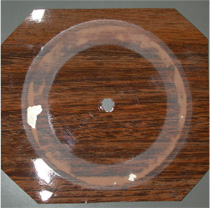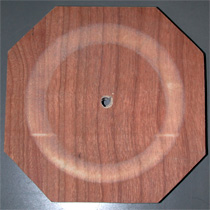Test Results of Tennâge
Test Results of Tennâge for Colorfastness / Bending Repulsion / Resistance to Flexing
Here are the test results of Tennâge for colorfastness, bending repulsion, and resistance to flexing. These test were conducted by Japan Synthetic Textile Inspection Institute Foundation (Kaken Test Center).
November 10, 2000
| Test Items / Method | Tennâge Anigre |
Tennâge Bamboo |
Cork | |
|---|---|---|---|---|
| Colorfastness to Light (Grade) JIS L 0842 |
Less than 3 | 3 | Less than 3 | |
| Colorfastness to Rubbing (Grade) JIS L 0849,Type II |
Dry | 5 | 5 | 3-4 |
| Wet | 5 | 5 | 3 | |
| Colorfastness to Water (Grade) JIS L 0848 Method A |
Color Change | 5 | 5 | 5 |
| Staining | 5 | 4-5 | 4-5 | |
Japan Synthetic Textile Inspection Institute Foundation (Kaken Test Center) Standard.
June 7, 2001
| Test Items / Method | Tennâge | Raw Wood | Wood Brid | Other Plywood | |
|---|---|---|---|---|---|
| Bending Repulsion (mN) JIS L 1096 Method A Note: Vertical Only |
V | 17.2 | 4.3 | 65.8 | 48.8 |
| Resistance to Flexing (Cycles) JIS P 8115 Extract Solution: pH 6.8 JIS L 1096 |
V | Over 1000 | 0 | 28 | 6 |
| H | Over 1000 | 0 | 85 | 15 | |
Certificate of Test Results.
Japan Synthetic Textile Inspection Institute Foundation (Kaken Test Center).
Test Result of Tennâge for Germ Resistance
Here is the test result of Tennâge for germ resistance. This test was conducted by Sinanen Zeomic Co., Ltd.
Test Method: Evaluated by Test Method of The Society of International sustaining growth for Antimicrobial Articles (SIAA).
Staphylococcus aureus: IFO12732
Escherichia coli: IFO3972
January 31, 2003
| Test Items | Staphylococcus aureus | Escherichia coli |
|---|---|---|
| Tennâge | <10 | <10 |
| Comparison | 2.2E6 | 2.5E7 |
| Bacterial count at the beginning | 4.6E5 | 4.0E5 |
Sinanen Zeomic Co., Ltd.
Test Result of Tennâge for Abrasion Resistance
Here is the test result of Tennâge for abrasion resistance. This test was conducted by Nara Forest Research Institute. This test result compared the abrasion resistance of Tennâge and the most common wood grain printed vinyl film.
June 2, 2006
| Most common wood grain printed vinyl film | Tennâge |
|---|---|
At the early stage of the test, the surface shine was lost by abrasion. After 300 spins, a part of printed wood grain was lost. After about 450 spins, vinyl film was damaged and some parts were completely torn.
|
*For the abrasion test of Tennâge, we needed to attach wooden sheet on the back of Tennâge. Total weight before test was 80.110g, total weight after test was 79.877g.
At the early stage of the test, the surface shine was lost by abrasion. After 300 spins, a part of wood grain was lost and backing material appeared. However, the backing material withstand until the end.
|
 |
 |
| Weight loss after abrasion of Tennâge was more than vinyl film. However, the damage by abrasion was more on vinyl film than on Tennâge. | |
Nara Forest Research Institute
Test Result of Tennâge for RoHs
Here is the test result of Tennâge for RoHs by SGS Japan Inc. Original PDF(in Japanese) is here(299KB).
September 26, 2013
| Item | Unit | Result | Preparation | Device/location | MDL |
|---|---|---|---|---|---|
| Lead (Pb) | ㎎/㎏ | Not detected | IEC62321-5: 2013 | ICP-OES | 2 |
| Cadmium (Cd) | ㎎/㎏ | Not detected | IEC62321-5: 2013 | ICP-OES | 2 |
| Mercury (Hg) | ㎎/㎏ | Not detected | IEC62321-4: 2013 | ICP-OES | 2 |
| Chromium VI (Cr(VI)) | ㎎/㎏ | Not detected | IEC62321: 2008 Annex C | UV/VIS | 2 |
| Polybrominated Biphenyls (PBBs) | |||||
| Monobromobiphenyl | ㎎/㎏ | Not detected | IEC62321: 2008 Annex A | GC/MS | 5 |
| Tribromobiphenyl | ㎎/㎏ | Not detected | 5 | ||
| Dibromobiphenyl | ㎎/㎏ | Not detected | 5 | ||
| Pentabromobiphenyl | ㎎/㎏ | Not detected | 5 | ||
| Tetrabromobiphenyl | ㎎/㎏ | Not detected | 5 | ||
| Heptabromobiphenyl | ㎎/㎏ | Not detected | 5 | ||
| Hexabromobiphenyl | ㎎/㎏ | Not detected | 5 | ||
| Nonabromobiphenyl | ㎎/㎏ | Not detected | 5 | ||
| Octabromobiphenyl | ㎎/㎏ | Not detected | 5 | ||
| Decabromobiphenyl | ㎎/㎏ | Not detected | 5 | ||
| Polybrominated Diphenyl Ethers (PBDEs) | |||||
| Dibromodiphenyl Ether | ㎎/㎏ | Not detected | IEC62321: 2008 Annex A | GC/MS | 5 |
| Monobromodiphenyl Ether | ㎎/㎏ | Not detected | 5 | ||
| Tetrabromodiphenyl Ether | ㎎/㎏ | Not detected | 5 | ||
| Tribromodiphenyl Ether | ㎎/㎏ | Not detected | 5 | ||
| Hexabromodiphenyl Ether | ㎎/㎏ | Not detected | 5 | ||
| Pentabromodiphenyl Ether | ㎎/㎏ | Not detected | 5 | ||
| Octabromodiphenyl Ether | ㎎/㎏ | Not detected | 5 | ||
| Heptabromodiphenyl Ether | ㎎/㎏ | Not detected | 5 | ||
| Decabromodiphenyl Ether | ㎎/㎏ | Not detected | 5 | ||
| Nonabromodiphenyl Ether | ㎎/㎏ | Not detected | 5 | ||
SGS Japan Inc.
Test Result of Tennâge for Food Contact
Here is the test result of Tennâge for food contact, conducted by Japan Food Research Laboratories. Original PDF(in Japanese) is here(440KB).
May 1, 2012
| Test Items | Result | LOQ* | Note | Method |
|---|---|---|---|---|
| Specification Test for Devices, Containers, and Wrapping (Synthetic Resin) | … | … | 1 | … |
| Standard Specification | … | … | … | |
| Elution Test | … | … | 2 | … |
| Heavy Metal | Inside of limit | … | … | |
| Potassium permanganate consumption | Outside of limit (15μg/ml) | … | … | |
| Elution Test | … | … | 3 | … |
| Arsenic (As2O3)(Solvent:4V/V% Acetic Acid) | Not detected | 0.05μg/ml | DDTC-Agabsorption Spectrophotometry | |
| Phenols (Phenol)(Solvent:Water) | Not detected | 0.5μg/ml | 4-Aminoantipyrine Spectrophotometry | |
| Formaldehyde (Solvent:Water) | Not detected | 0.5μg/ml | Acetylacetone Absorptiometry |
- Note 1 : Specification standard of food and additives (Notification No. 370 of the Ministry of Health and Welfare in 1959) Article 3-D-2, devices, container and wrapping made by synthetic resins. Category: Temperature, below 100℃
- Note 2 : Test Surface: Wood Grain Side
- Note 3 : Condition of Elution:Elute for 30 minutes in 60℃, using 2ml of solvent for 1cm2 area of test surface (wood grain side).
- *Note : LOQ=Limit of Quantitation
Japan Food Research Laboratories

